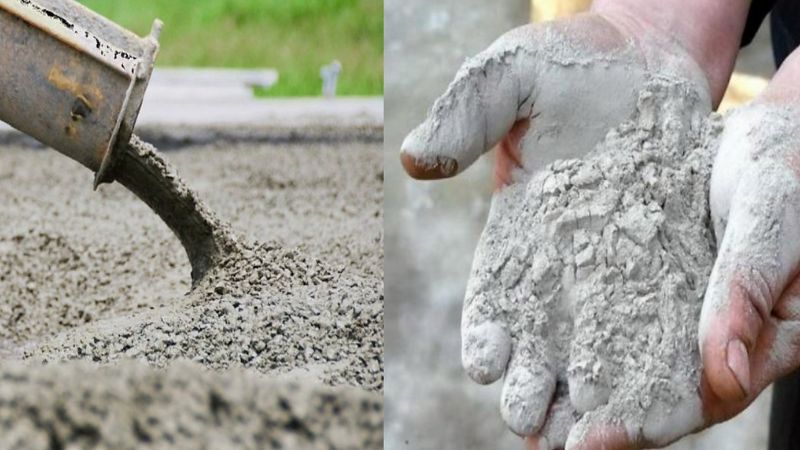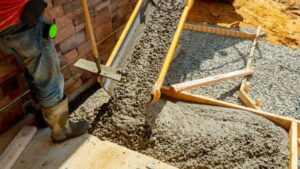Difference Between Cement and Concrete – When it comes to construction and building projects, the terms “cement” and “concrete” are often used interchangeably, but they are not the same. Understanding the difference between these two materials is essential for anyone involved in home improvement or construction. Cement is a fine powder made from minerals that, when mixed with water, forms a paste that binds other materials together.
On the other hand, concrete is a composite material that consists of cement, water, aggregates (like sand and gravel), and sometimes additives to enhance its properties. In this blog, we’ll delve into the characteristics, uses, and benefits of cement and concrete, helping you make informed decisions for your next project.
Difference Between Cement and Concrete
1. Composition
Cement and concrete, while often confused, are fundamentally different in their composition. Cement is a fine powder made primarily from limestone and clay that has undergone a heating process in a kiln, resulting in a substance known as clinker. This clinker is then ground into a fine powder to create cement. When combined with water, cement functions as a binder.
On the other hand, concrete is a composite material that includes cement, water, aggregates (such as sand, gravel, or crushed stone), and sometimes additives to enhance its properties. The combination of these components creates a strong, durable material that can withstand various environmental conditions, making concrete a preferred choice for construction projects.
Also Read:- Tips To Prevent Concrete Cracking
2. Functionality
The functionality of cement and concrete is another area where they differ significantly. Cement serves as a binding agent that holds together different materials in a construction mix. When water is added to cement, it undergoes a chemical reaction called hydration, which allows it to harden and bond materials together. Concrete, however, is the finished product used for construction purposes.
It combines cement with aggregates and water, resulting in a material that has excellent compressive strength, making it suitable for a wide range of applications, including pavements, foundations, and structural components. The dual roles of these materials highlight their distinct functionalities in the construction process.
3. Strength and Durability
When comparing strength and durability, concrete outperforms cement due to its unique composition. While cement alone can set and harden when mixed with water, it does not possess the necessary structural integrity to bear loads. In contrast, concrete, which includes aggregates, exhibits high compressive strength, allowing it to support significant weight and resist various forces, including weather conditions and environmental stressors.
Additionally, concrete’s durability is enhanced by its resistance to fire, water, and wear, making it an ideal choice for long-lasting structures. This difference in strength and durability is a crucial consideration for construction projects, as it determines the material’s suitability for specific applications.
4. Application
The applications of cement and concrete also illustrate their differences. Cement is primarily used as a binder in various construction mixtures, including mortar, grout, and concrete itself. It is suitable for projects that require smaller-scale applications, such as tile installation or repairing cracks. In contrast, concrete is used in large-scale construction projects, including bridges, highways, and buildings.
Its versatility and strength make it ideal for applications that require robust materials. Additionally, concrete can be molded into various shapes and sizes, allowing for creative designs in architectural projects. The distinct applications of each material emphasize their unique roles in the construction industry.
5. Setting and Curing Time
Another key difference lies in the setting and curing time of cement and concrete. Cement, when mixed with water, begins to set quickly, typically within 30 minutes to a few hours, depending on the specific type of cement used and environmental conditions. However, it requires a longer curing period to achieve maximum strength. Concrete, on the other hand, has a more extended curing process.
While it may begin to set within a few hours, it can take several days or even weeks to cure fully and reach its optimal strength. Proper curing of concrete is essential, as it affects the final durability and performance of the material. Understanding these time frames is crucial for construction planning and scheduling.
6. Cost
The cost of cement and concrete varies significantly, influenced by their production processes and components. Cement is typically less expensive than concrete because it is a single material produced from raw ingredients like limestone and clay. The price of cement can fluctuate based on market conditions, but it generally remains lower than that of concrete.
In contrast, concrete’s cost includes not only the price of cement but also aggregates, water, and any additional additives or admixtures used to enhance its properties. As a result, concrete is usually more expensive than cement per cubic meter. However, the investment in concrete often pays off due to its strength and durability, making it a cost-effective choice for long-term construction projects.
Also Read:- How To Repair Cracks in a Concrete Driveway
7. Environmental Impact
The environmental impact of cement and concrete production is an important consideration in today’s construction industry. Cement manufacturing is known to produce a significant amount of carbon dioxide (CO2), contributing to global warming. The process of extracting, processing, and heating raw materials releases greenhouse gases, making cement one of the major contributors to carbon emissions.
In contrast, while concrete also has an environmental footprint, its overall impact can be mitigated through sustainable practices, such as using recycled aggregates or incorporating alternative cementitious materials, like fly ash or slag. Additionally, the durability and longevity of concrete structures can lead to reduced resource consumption over time. As awareness of sustainability grows, the construction industry is increasingly focusing on minimizing the environmental effects of both cement and concrete.
Conclusion
In conclusion, although having certain similarities, cement and concrete have distinct uses in the building industry. Cement acts as a binding agent, whereas concrete is a robust building material made from a mixture of cement, aggregates, and water. Knowing these Difference Between Cement and Concrete can help you select the right material for your specific needs, ensuring durability and efficiency in your projects. Whether you’re building a patio or a foundation, understanding these concepts will guide you toward success.
FAQs
Can I use cement instead of concrete for construction?
No, cement is a binding agent and cannot be used alone for construction. Concrete, which contains cement along with aggregates and water, is necessary for creating durable structures.
What is stronger, cement or concrete?
Concrete is generally stronger than cement because it includes aggregates that enhance its structural integrity. Cement alone does not have the same strength and durability as concrete.




